All the models in chronological order as produced by Streetly Electronics.
The Mellotron – Mark I
The first Mellotron produced was the Mark I which had two 35 note (G – F) keyboards side by side housed in a very elegant wooden case. The finish was not dissimilar to a decent upright piano as the instrument was originally a home instrument along the lines of an electronic organ. The first set of sounds reflected this as the very early ones had NO VIOLINS!
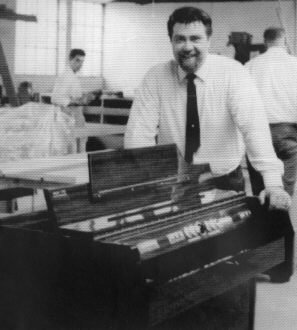
However the Mellotron was an advanced instrument for its time (1963), as Mellotronics put it in their own brochure:-
The Mellotron is a revolutionary keyboard instrument providing pure music on triple channel pre-recorded tape. 18 different rhythms can be selected on the left-hand keyboard by means of a simply operated press button panel. On the right-hand keyboard 18 different lead instruments are available on which you can play the melody of your choice. The ingenious numbering system enables anyone with the slightest knowledge of music to play this fascinating instrument of the 60’s.”
MEASUREMENTS: 39″ High x 51″ Wide x 27″ Deep. WEIGHT: 350lbs.
VOLTAGES: The instrument operates on all normal voltages.
AMPLIFICATION: Transistorised amplifiers of special design are fitted together with full range volume controls.
LOUD SPEAKERS: Two 12″ heavy duty loudspeakers of high quality fitted. Output capacity 15 Watts each. Built in jacks for independent loudspeakers fitted as standard.
INSTRUCTION MANUAL: A comprehensive instruction manual accompanies each instrument.
GUARANTEE: Each instrument carries a 12 months guarantee.
SERVICING: A service organisation is available.
EXTENDED AND RENTAL TERMS NOW AVAILABLE
Only 55 were made, mostly in 1963. Most were converted to MarkII specifications when serviced.
The Mellotron – Mark II
The Mark I was quickly followed in 1964 by the improved Mark II. Most Mark I’s were converted to Mark II spec as well so if you come across an original Mark I (that still works) you are looking at a very rare keyboard.

Also having two 35 note (G – F) keyboards side by side and built – in amplification it looked very similar. As with the Mark I the Mark II had prerecorded accompaniments and rhythms on the left hand keyboard and eighteen ‘lead’ sounds on the right hand keyboard although some were re-recorded. The sounds were arranged in six banks of three sounds with selection between the three sounds in a bank being instant. However changing banks could take up to twenty seconds as all 35 tapes had to be moved to new positions (or ‘stations’) before playing could continue. Some sounds of note from the Mark I / Mark II include violins (of course), flutes, brass, massed mandolins and ‘spanish guitar phrase’ (as used by the Beatles on the intro to ‘Bungalow Bill’).
This is the model of Mellotron used on many of the famous recordings of the late sixties which comes as a surprise to most people. Recording studios sometimes used a modified version called the FX console with the tapes from a Mark II fitted.
There was also an offshoot of the Mark II and was produced for the BBC that was called the FX Console. It had 1260 sound effects (recorded by the BBC) and was used for adding sound effects to radio and TV productions such as Doctor Who.
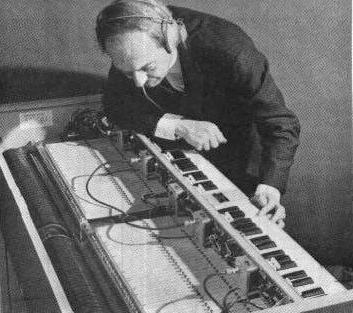
Changes to the specifications included improved signal to noise ratio and removal of the internal amplification system (replaced by a small mono monitor amplifier and headphone socket) and of course a regulation BBC grey finish. Over the years some of these machines have had music tapes refitted to them, giving an instrument that is sought after for recording, the Abbey Road machine was one of these.
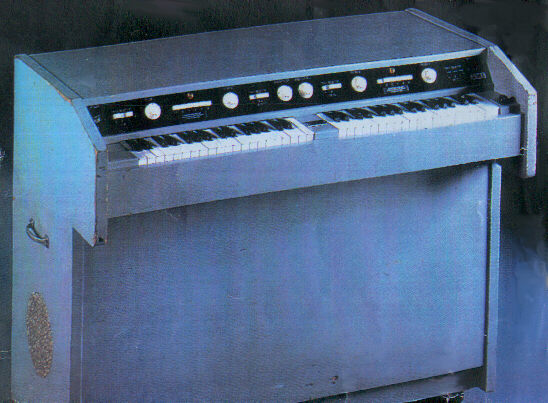
About 60 FX consoles were made between 1965 and 1970.
About 250 (excluding the FX machines) were made between 1964 and 1968. Superceded by the M300.
The Mellotron M300
The 300 followed the Mark II and was the only production model that used 1/4″ tapes. It had a single 52 note (A-C) keboard although it still had the left hand accompaniments. The recordings were all new (including the “melancholy” violins) and now included piano, harpsichord, celeste, clarinet, trombone vibes and several electronic organs(!). They were better recordings than before as Streetly learned which sounds worked well. The left hand included rhythms such as samba, quickstep, latin and several waltzes with more ‘open’ chords than before making them more versatile .A few selections allowed an instrument such as piano, organ or cello to appear on the left hand as well making all 52 notes either a single instrument or allowing a split between two instruments.
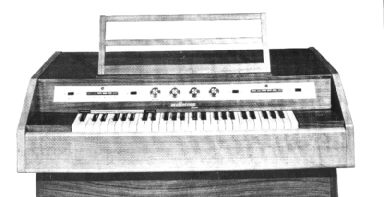
The mechanical selector of the Mark II was replaced by a solenoid based system and the reverb was replaced by a Hammond manufactured spring line. Unlike the Mark II the instrument had no internal amplification although there was the the ‘LSA’, an optional two-way amplifier / speaker unit available. The only down side was the cost-cutting exercise introduced by Mellotronics (the parent company in London) who insisted on removing the pitch control and replacing the motor control and DC motor with a fixed speed AC motor. The reasoning behind this was that a ‘home keyboard’ does not need to be tuned to anything else (a bit short-sighted really).
Used by both Gentle Giant and Barclay James Harvest it was not the most famous model made. However the folklore of the unreliability of Mellotrons came mainly from the M300 as once the self lubricating properties of the Fluon tape guides failed the the result of changing banks was often broken tapes as they were more fragile than the 3/8″ tapes used on other models. This can be cured by putting a more conventional style of tape guide in (20-20 hindsight in action here).
About 60 were produced between 1968 and 1970. Superceded by the M400.
The Mellotron- M400
The M300 was followed by the most well known and successful model, the M400. To make the instrument simpler and thus lighter (note lighter = 122lbs or 55kg) the bank changing mechanism was removed and the tapes were supplied on easily changed frames (see ‘How it Works’). This meant that only three sounds could be accessed quickly but as most people were using Mellotrons in combination with other keyboards this was not a problem.
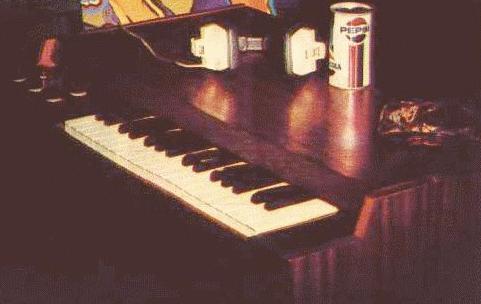
The range of sounds available was far wider than before coupled with the ability to order any combination from the Mellotron library or even ones recorded by the user could be put onto custom frames by the manufacturer. Mellotronics offered 8 string sounds, 5 woodwind sounds, 8 brass, 5 choirs, 3 organs, 11 ‘acoustic percussion instruments’ and 11 ‘electronic percussion instruments’ and a large number of sound effects.
This is because a variant of the M400 (called the 400FX) was available to special order to replace the FX console once the production of Mark II’s had ended. What you ended up with was an grey or black M400 with the tone control replaced by a ‘monitor’ control that determined the volume of the signal coming out of the additional headphone socket on the front. This allowed the operator to determine what the next sound effect cue sounded like while the main volume was down which was more useful than the original tone control as EQ and effects would be added externally. As the M400 has no cycling mechanism the 400FX were supplied with eleven additional tape frames in cases (1260 sounds in all) to make it equivalent to the original FX console. It was claimed by Streetly that a set of tapes could be changed in two minutes. I can confirm that, with practice, that this time can be easily improved on (especially with the help of an assistant).
About ten 400FX’s were made between 1970 and 1984 although another twenty or so standard M400’s were converted and sold as FX machines to various broadcasting companies around the world.
A conversion kit was also made available that allowed the owner to make their own tapes based on standard 1/4″ tape. This meant that only two sounds were available on homemade ‘custom’ frames.
Only four controls to worry about, volume, tone, pitch plus track selector and only 35 keys (G – F). Although fabled to be extremely unreliable I was in a band that gigged two M400’s for several years and they never once let us down (I still have one of them). The secret was to load them into the van last, take them into the gig and power them up on arrival so they could warm up and then play every note to make sure nothing had stuck in transit. One of the enemies of a Mellotron is change of temperature as this can cause condensation to occur on parts like the capstan, this can cause a tape to stick thus breaking it.
A padded cover was available called the Protecta-muff that looked like bondage trousers for a Mellotron (all straps, buckles and black PVC) that protected the instrument in transit and made it easier to carry as it had handles.
The M400 was also slightly modified and supplied as the 400 FX console, see FX Console for more details. There was also the Mark V, a two manual derivative that used the same tape frames, that was produced in small numbers.
The Novatron is also an M400 although the name was changed when Streetly Electronics lost the rights to the name when Mellotronics was sold off.
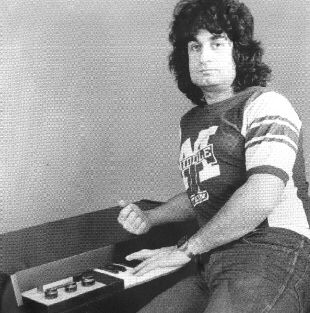
If you look carefully (above the three knobs on the photo) you can see the ‘Novatron’ label stuck over the ‘Mellotron’ label. So if you are looking for a Mellotron and see a Novatron for sale then don’t pass it by as it is exactly the same instrument.
A rare variation of the Novatron was the T550 that was basically a Novatron 400SM built into a flightcase. Operationally identical the flightcase version had additional storage space in the removable lid for the volume pedal and two additional tape frames, sadly only 3 were made c.1982 (I’d love one…).
In total about 2000 M400’s were produced between 1970 and 1986. This includes all Novatrons, the one-off teak flavoured batch of 100 produced by EMI in the mid seventies, the unique ‘vinyl one’ that I now own and the left-handed one produced for Paul McCartney.
The Mellotron – Mark V
A variation on the M400 that also holds memories of the original Mark I was the Mark V that was basically two 400’s side by side with a common capstan.
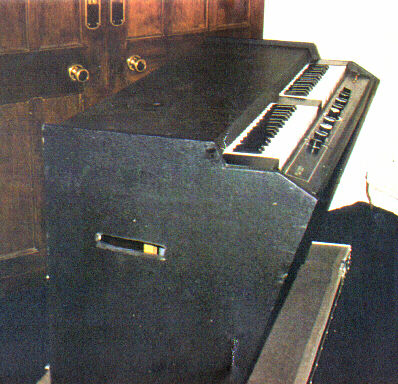
To make the instrument narrower and to give it a more modern ‘thrusting’ look the controls were mounted in front of the two keyboards and the cabinet was covered in black tolex. The controls were the usual M400 Volume, Tone and Pitch plus Reverb (not present on the M400). Outputs were stereo and a headphone socket was provided.
Only 30 were produced in total between 1975 and 1984. After the enforced name change in 1977 the model became known as the Novatron Mark V but these are extremely rare.
The Streetly – M4000
Not strictly a historic machine but a current product of Streetly, see separate page for details…